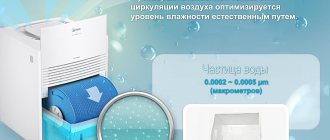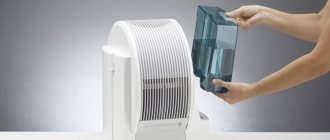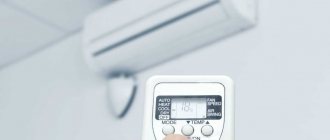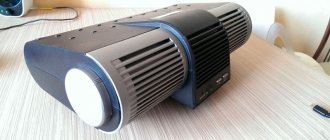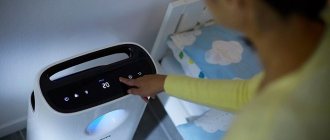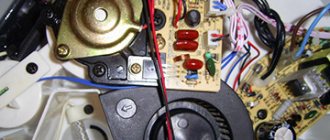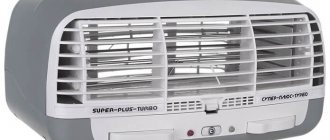General Approach to Engineering a Home Purifier
Carbon filters for air purifier
- The housing has slots for the intake of dirty air and the removal of clean air masses.
- Cleansing and ionizing filter.
- A dust collector consisting of installed electrodes with oppositely polar charges.
- Electronic controls for automatic control.
- Power supply to start the device.
Principle of operation
The corona charge created on the electrode produces charged ions. As they move, they capture dust particles and bacteria. When such ions settle on the electrode, they “stick” harmful components of the air with them. Clean air is supplied back into the room. A simple operating algorithm allows you to use the device in any type of room. It is suitable for small rooms whose area does not exceed 20 m2.
Advantages
- Effective removal of dust particles whose size does not exceed 1 micron. Simple repairs can cause large amounts of dust to appear.
- Minimum electrical energy consumption, since the power of modern devices does not exceed 45 W.
- The installed filter does not need to be replaced. If it gets dirty, simply wash it under running water at least once every 10 days in case of intensive use.
- Models without a fan do not create sound, which allows them to be used in a child’s room or at night.
In this case, it is not at all necessary to purchase a ready-made device. You can make your own indoor air purifier with a little effort and a little time. This will ultimately result in cost savings.
The website YOUVENT.RU is closed
In general, the question about what fresh air is is very complex and subjective.
You need to understand that air is a soup with many ingredients. Actually, the broth itself is gases, that is, molecules several nanometers in size. The main gases in the air are nitrogen (about 80%) and oxygen (about 20%). In addition, potatoes and cabbage float in the broth; if you’re lucky, then the meat is the “thickness”.
These are aerosol particles. These are objects much larger than gas molecules, for example, dust particles, pollen, bacteria and viruses, liquid droplets, etc. The grounds come in different sizes - from dill to a piece of meat. Plus, the soup contains salt and spices that are dissolved in the broth; this is the ionic composition of the air, that is, some of the gas molecules are not neutral, but carry an electric charge, plus or minus. Well, the air also has temperature and humidity. From this whole heap the soup is cooked, in one case it will be borscht, in another gazpacho, in the third it will be dietary broth.
Passive filters can only filter particles of a certain size. For example, the coarsest filters retain very large particles; they are not able to retain bacteria and soot microparticles, but high-efficiency HEPA filters can retain the entire spectrum of particles. In general, according to the physics of the matter, the removal of particles does not in any way affect the “taste” of the air. Just like if you remove the grounds from a finished soup, the taste of the broth will not change. Filtration always makes things better, because we don't need particles in the lungs, we need oxygen. In general, we ourselves have a filter for large particles - this is the nasopharynx and bronchi, and they trap large dust that comes out with mucus. But the bronchial tubes do not retain microparticles; they enter the lungs, impairing their functioning.
The gas composition of the air is very important. Usually, in the absence of an influx, CO2 accumulates in the air, which we actively release when breathing. Hence, poor sleep and lethargic health. The lack of oxygen will be felt much less, because There is 20% of it in the air, and 0.03% of CO2, and its fluctuations are very sensitive for our body. Also inside the building, a lot of chemical hazards are released from furniture and finishing materials, again formaldehyde. Plus an infection that people secrete. To combat these problems, it is necessary to replace dirty air with clean air from the street. But the air from the street contains a bunch of harmful gases, for example, formaldehyde, exhaust gases, etc. To combat them, different filters are installed, catalytic and sorption. Odors are basically the same gases, just with a more complex organic structure. All existing filters do not remove oxygen, nitrogen, CO2 from the air, but only complex organics, oxides, formaldehyde and other gases, and the composition of the removed gases depends on the type of filter. Many filters generally remove gases very poorly, others remove only a certain set of gases, and still others only fight large organic matter. In general, such filters are unlikely to make the air “stale”; rather, they can remove some impurities that we associate with this freshness - for example, ozone. By the way, ozone is a gas of the first toxicity category, and breathing a constant excess of ozone is not healthy at all!
Ionic composition is the most unexplored topic. There is no direct scientific evidence about how it affects health or what it should be. There are various speculations about the dangers of positive air ions and the benefits of negative ones, but my opinion is this: if you don’t know, don’t touch it! Therefore, it is better not to change the ionic composition of the air, all sorts of ionizers are at best a placebo and an imitation of freshness, and at worst they are harmful - charged dust very much tends to be attracted to something, like hair to a comb, therefore, by inhaling it into yourself you are much more You clog your airways and lungs faster!
So I think, in fact, fresh air is the absence of harmful gases and odors, the absence of dust and infection, low CO2 content and sufficient oxygen content. But the subjective sensations of freshness are very much determined by humidity and temperature. There may be a lot of oxygen in the air, but due to the high temperature and humidity, it seems stuffy and stuffy to us. So, objectively, there should be a good flow of street air into the apartment, at least 30 m3/hour per person, maximally purified from particles and foreign gases. The rest is subjective factors. Something like this.
DIY electrostatic air purifier: option No. 1
The design of a professional air purifier presented below allows you to determine how to install the device yourself. According to the proposed scheme, you can make the device yourself. The components of the mechanism are purchased in specialized stores, or replaced with improvised means. For example, the HEPA filter is replaced by carbon elements, the coarse filter is replaced by a porous material, and the ionizer may not be used in the design.
Diagram of a homemade purifier
This scheme works with artificial supply of polluted air. A conventional fan can be used to move air masses. By connecting such a cleaner to power, you can eliminate dust within 12 hours. But its main disadvantage is the production of ozone, which in large quantities is harmful to the human body.
Important! Using an additional filter based on activated carbon and installing a partition with silica gel will allow you to more effectively and quickly remove dust particles from the air.
DIY air purifier for home: option No. 2
Required structural elements
- A small fan whose voltage is 12 V.
- Power supply: Krona battery.
- Terminal for connecting a power source.
- Plastic container corresponding to the dimensions of the fan.
- Filter element: carbon.
Manufacturing process
Cleaner in a plastic container
- Apply markings on the prepared container to make holes for the entry and exit of air masses.
- At the bottom of the container, apply cut lines that correspond to the dimensions of the battery.
- Using a terminal, connect the fan to a power source - a battery.
- Check the functionality of the assembled structure.
- Place the finished structure in a plastic container.
- Cut the carbon filter to the size of the container.
- Place the filter element on top of the fan.
Important! To increase the reliability of the design, it is better to solder the battery to the fan. This will eliminate power supply interruptions and, accordingly, increase the efficiency of using the device.
Homemade dust air purifier with humidification: design No. 3
To implement the task, the following are used:
- volumetric plastic container with a lid;
- 12 V power supply that can be connected to the mains;
- fan of small dimensions;
- filter element.
The design principle is similar to No. 2: a hole is made in the plastic tank for installing a fan and power supply. The fan is firmly fixed in the upper part of the container using bolts to prevent it from sinking into the water. Water is poured into the lower part of the plastic tank. The liquid should not reach the fan by at least 3 cm. This device can be equipped with a relay with which you can automatically control the structure: it will turn on and off independently after a certain time, which, you see, is very convenient.
Filter for indoor air purification
Greetings to you DIYers and just readers!! The author of the homemade product that we will now consider often works in a garage, which is also a workshop. Since dust is generated during the work of the master, the author decided to make a filter to purify the air in his workshop. The filter turned out to be quite inexpensive and quite simple to manufacture. You will not need any specific tools or materials during the manufacturing process.
Tools and materials
-Exhaust fan (diameter 125mm) -Car air filter (for the GAZelle brand) -Electric wire -Plug -Metal corner (if necessary) -Screwdriver -Clerical knife -Glue gun -File -Pliers
Manufacturing process.
To make this device, the author purchased an air filter for a GAZelle car and an ordinary household exhaust fan with a diameter of 125mm.
The protective mesh from the fan can be safely put aside; we won’t need it. We need to connect the fan with the suction side to the filter, so that when the fan is running, the air passes through the filter and then through the fan.
This fan model has a front panel that needs to be removed. The author cuts it off using a utility knife, although with the help of an angle grinder it would have gone faster. It’s even better to immediately buy a fan without such a panel (duct fan)
Connects the wire to the fan. The fan terminals are hidden under a protective cover; it needs to be opened by simply prying it off with a screwdriver. On some models this cover is screwed on.
That's all, the device is almost ready, all that remains is to secure it.
But before you attach it, you should check for functionality. The author turned on the fan in the network, as you can see, the device functions as required. The air flow passes through the filter to be cleaned, then the clean air passes through the fan. This way the fan blades will also always be clean and you won’t have to remove it for cleaning. The flow force is enough to hold a sheet of newspaper.
The filter is mounted in its rightful place and is ready for use.
After using the air filter for four days, the author removes it to evaluate the effectiveness of this homemade product. For clarity, the author blows dust from the filter cells with a stream of compressed air from a compressor. As you can see, quite a bit of dust flies out, which means the device copes with its task and cleans the air quite effectively.
This article is finished, thanks to everyone who read to the end. I wish you successful projects and an inexhaustible amount of ideas. Source
 You need to understand that air is a soup with many ingredients. Actually, the broth itself is gases, that is, molecules several nanometers in size. The main gases in the air are nitrogen (about 80%) and oxygen (about 20%). In addition, potatoes and cabbage float in the broth; if you’re lucky, then the meat is the “thickness”.
You need to understand that air is a soup with many ingredients. Actually, the broth itself is gases, that is, molecules several nanometers in size. The main gases in the air are nitrogen (about 80%) and oxygen (about 20%). In addition, potatoes and cabbage float in the broth; if you’re lucky, then the meat is the “thickness”.